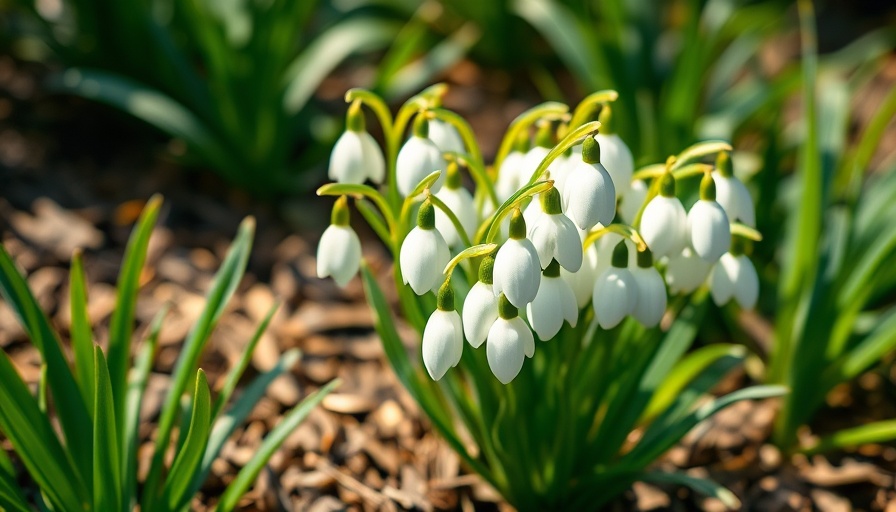
The Early Blooms of Spring: An Introduction to Snowdrops
As the winter chill begins to fade, the snowdrop flowers (Galanthus spp.) emerge bravely through the last remnants of snow, marking a transition into spring. These hardy little bulbs, which originate from Eurasia, are among the earliest blooming plants, known for their delicate white flowers and unique ability to thrive in cooler climates. When planning your garden, incorporating snowdrops can create stunning visual contrasts as they peek out from under the snow, heralding the season of renewal.
Understanding Snowdrop Characteristics
Snowdrops grow from true bulbs that allow them to withstand the challenges of winter freeze and summer droughts. These bulbs can be a delightful addition to any yard, especially since they often naturalize in gardens, forming clusters that beautify spaces over the years. When nurtured properly, snowdrops can also easily be propagated, providing a rewarding gardening experience as these flowers spread and fill your outdoor areas with charm.
How to Successfully Plant Snowdrops
The ideal conditions for snowdrop cultivation include well-drained soil and partial to full sunlight. While it’s best to plant the bulbs in the fall, planting “in the green” can also yield beautiful results during spring. When planting, ensure that bulbs sit about three inches deep in the soil and are spaced approximately three inches apart. This method encourages healthy growth and allows for easy division in the future.
Designing Your Snowdrop Garden
Considering the layout of your garden can greatly influence the effectiveness of snowdrops in your landscape. Planting them in clusters of 25 or more creates a more significant visual impact. Snowdrops thrive under deciduous trees where they can take advantage of early spring sunlight. Use them to line walkways or as a cheerful complement at the front of flowering shrubs, as their striking presence shines through early blooms.
Care and Maintenance of Snowdrops
One of the appealing aspects of snowdrops is their low maintenance nature. These flowers generally have no significant pest issues and tend to thrive with minimal intervention. Once established, they only require consistent watering during warm periods, and a sprinkling of bulb fertilizer in the fall can help boost their nutrients. After blooming ends, it’s crucial to let the foliage remain until it turns yellow, as this allows the plant to gather energy for next year’s blooms.
Potential Challenges with Snowdrop Cultivation
Despite their resilience, snowdrops are not entirely without challenges. They prosper best in USDA hardiness zones 3 through 7, which can limit their growth in warmer climates. Additionally, while deer tend not to eat these bulbs due to their toxic nature, gardeners in such environments can explore additional methods to ensure that pests are kept at bay. Furthermore, gardeners should avoid disturbing the bulbs while they are dormant to maintain their vigor and productivity.
Broader Implications: A Sustainable Approach in Muskegon
In Muskegon, where outdoor gardening is popular among homeowners, growing snowdrops contributes to sustainable landscaping practices. Establishing snowdrops can help create a symbiotic environment as they attract pollinators while providing a tremendous aesthetic benefit. As you embark on your snowdrop journey, consider incorporating other garden projects, such as constructing outdoor soil beds or starter garden projects. Investing in a well-designed outdoor space not only adds value to your property but also enhances community engagement through shared gardening experiences.
For those considering landscaping improvements, starting a backyard planting box or building elevated planter boxes not only provides a practical approach to gardening but can also serve as a beautiful extension of your home’s outdoor area. Engaging in these projects this spring paired with the budding beauty of snowdrops can enhance the coziness and vibrancy of your surrounding environment.
Conclusion: Embrace the Beauty of Snowdrops This Spring!
Incorporating snowdrops into your garden is a joyful and rewarding experience that signals the arrival of spring. Their easy propagation, charming appearance, and resilience make a compelling case for any DIY gardener. As you prepare your yard for the planting season, think about how you can combine the beauty of snowdrops with practicality in other garden endeavors. Whether you're looking to construct a decorative garden utility house or revamp your outdoor space, the delightful snowdrop can be a star in any newly designed yard.
 Add Row
Add Row 
 Add
Add 


Write A Comment